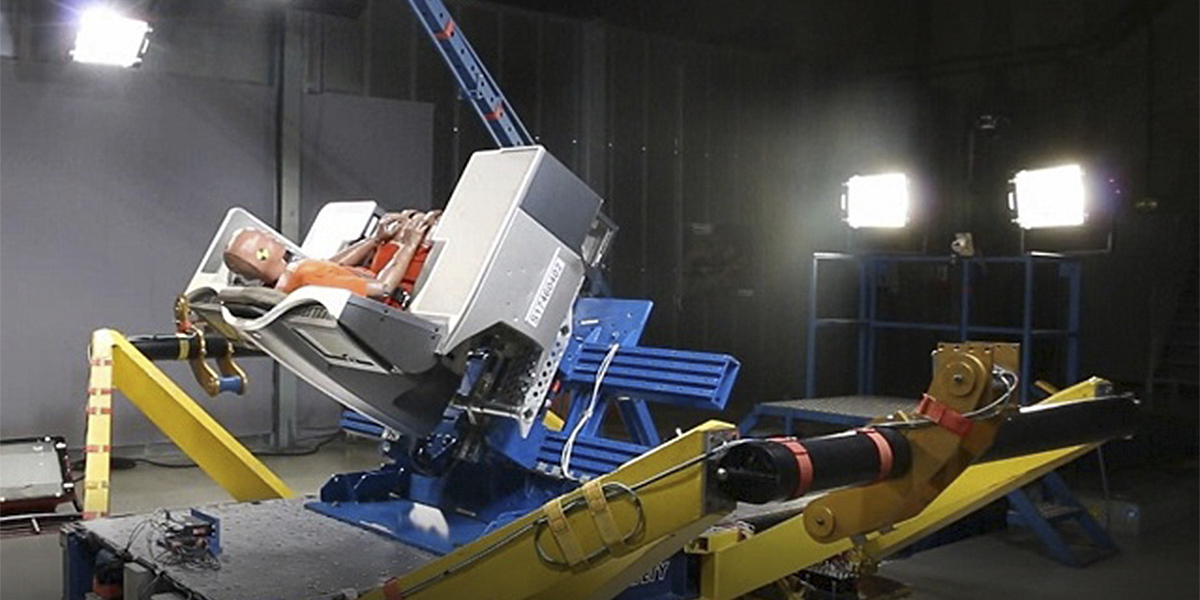SAE J2742 Electric Vehicle Airbag Deployment Testing
The SAE J2742 standard is a critical benchmark in the automotive industry, setting forth the guidelines for testing electric vehicle (EV) airbag deployment systems. This standard ensures that EVs are equipped with reliable and effective passive safety systems capable of protecting passengers during high-impact collisions.
Electric vehicles present unique challenges to traditional airbag design and testing due to their complex electrical systems and the need for energy-efficient components. SAE J2742 addresses these issues by specifying a series of tests that simulate real-world scenarios, ensuring that EV airbags deploy safely and reliably without causing additional risks.
One of the primary challenges in testing electric vehicle airbag deployment is the integration with the battery management system (BMS). The BMS must be able to detect an impact and trigger the airbag deployment sequence without compromising the integrity of the electrical system. SAE J2742 addresses this by requiring comprehensive diagnostics that ensure the BMS operates correctly during the test.
The testing protocol outlined in SAE J2742 involves a series of steps to simulate the conditions under which airbags should deploy. These include:
- Accelerometer calibration and validation
- Battery voltage monitoring during deployment
- Testing at different temperatures to ensure reliability
- Evaluation of electromagnetic interference (EMI) effects on airbag functionality
The test setup typically involves a specialized rig capable of simulating real-world crash scenarios. The rig must be able to replicate the forces and impacts experienced during an accident, ensuring that the airbags perform as expected under these conditions.
Once the deployment is triggered, the system must ensure that:
- The airbag deploys within a specified time frame
- No components are damaged by the deployment process
- The airbag does not interfere with other safety systems or electrical components
Testing must also consider the potential for electromagnetic interference (EMI) from the vehicle's electrical system. This is particularly important in electric vehicles, where a malfunction could have severe consequences. SAE J2742 requires that tests be conducted under controlled EMI conditions to ensure that airbag deployment is not compromised.
Another critical aspect of SAE J2742 testing is the evaluation of the airbag's performance in different environmental conditions. Temperature variations, for instance, can affect the behavior of materials used in airbags and their electrical components. The standard specifies a range of temperatures under which tests must be conducted to ensure that the airbag functions correctly across various climates.
Finally, SAE J2742 also covers the documentation and reporting requirements for these tests. This includes detailed records of test conditions, results, and any anomalies observed during testing. The aim is to provide a comprehensive report that can be used by manufacturers to improve their airbag systems and ensure compliance with safety regulations.
Benefits
The benefits of adhering to the SAE J2742 standard are numerous. First, it ensures that electric vehicle airbags meet the highest standards of reliability and performance. This is crucial for maintaining consumer trust in EVs as a safe mode of transportation.
Compliance with this standard also helps manufacturers avoid costly recalls and legal issues associated with safety failures. By ensuring that all components work together seamlessly, SAE J2742 reduces the risk of post-accident malfunctions that could endanger passengers or other road users.
The standard also facilitates international trade by aligning testing protocols across different regions. This is particularly important for electric vehicle manufacturers who operate globally and need to ensure their products meet local safety standards.
For quality managers, compliance with SAE J2742 provides a clear framework for evaluating the performance of airbag systems. It allows them to identify potential issues early in the development process, ensuring that any necessary adjustments are made before production begins.
R&D engineers benefit from this standard by having access to a robust set of guidelines that can help improve the design and functionality of electric vehicle airbags. The detailed testing protocols provided by SAE J2742 allow them to innovate while maintaining safety standards.
For compliance officers, adherence to SAE J2742 simplifies the process of ensuring regulatory compliance. It provides a standardized approach that can be followed across different jurisdictions, reducing the complexity and cost associated with meeting diverse safety requirements.
Quality and Reliability Assurance
Ensuring quality and reliability in electric vehicle airbag deployment testing is paramount. The SAE J2742 standard plays a crucial role in this process by providing clear, detailed guidelines that help manufacturers achieve these goals.
The first step in ensuring quality and reliability is thorough preparation of the test specimen. This involves calibrating sensors and other components to ensure accurate measurements during testing. It also includes verifying that all electrical connections are secure and functioning correctly before the test begins.
During the test, real-world conditions must be simulated as closely as possible. This requires the use of sophisticated equipment capable of generating precise impact forces and monitoring various parameters throughout the deployment process. The accuracy of these measurements is critical for ensuring that the airbag performs optimally under realistic conditions.
The data collected during testing provides valuable insights into the performance of the airbag system. This information can be used to identify areas where improvements are needed, such as enhancing the durability of certain components or optimizing the deployment sequence. By continuously refining these aspects based on test results, manufacturers can improve their products over time.
Quality assurance is further enhanced through regular audits and reviews of testing procedures. These activities help ensure that all tests are conducted consistently and that any deviations from standard protocols are promptly addressed. This systematic approach to quality control helps maintain high standards throughout the development lifecycle of electric vehicle airbags.





